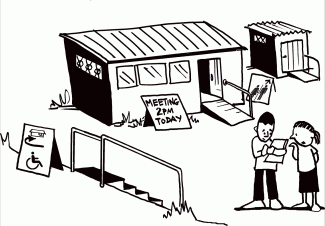
Barriers are obstacles which prevent people from fully participating in society. They can be environmental, attitudinal or institutional:
-
Environmental barriers include physical barriers, for example the presence of stairs to enter school or a camp registration facility where ramps and handles have not been installed; but also, communication barrier that occurs when information is inaccessible for some people (for example blind or deaf people, people who cannot read or people with learning disabilities).
-
Barriers linked to negative attitudes can result from stereotypes. For example assuming women with disabilities not needing reproductive health because they are considered to be 'asexual' or assuming that persons cannot participate to cash for work programmes because they have a disability or are older.
-
Institutional barriers are policies, procedures, or situations that systematically disadvantage certain groups of people.
Many barriers exist prior to disaster, while others might be created by the disaster or the humanitarian response.
***COVID-19 specific information***
Accentuation of some barriers are increasingly seen linked to COVID-19 outbreak. Make sure that the barriers usually observed are taken into account by your teams: think and build communication methods so that the information is accessible to all. As access to communities can be complicated during episodes of confinement, preparation for these periods should be reinforced upstream, including hygiene education for vulnerable people and their caregivers. Also note that increased stigmatization of persons with disabilities due to inaccurate associations and prejudices may occure during crisis. For example, some people may refuse care to persons with disabilities due to fear of contracting COVID-19, or assume that persons with disabilities can not continue in their current activities or jobs and make their own decisions in relation to exposure risk. Therefore, make sure to include advocacy actions when engaging with new partnerships, and include DPO on these actions.
**************************